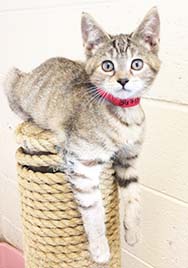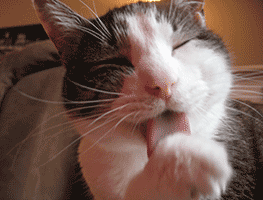The Truth about Declawing
Will Declawing my Cat Reduce Damage to Household Items?

The Wisconsin Humane Society works hard to save cats. We provide extensive medical services and socialization for cats that are abandoned and we love every one of them for their beauty and unique personalities. The last thing that we want is for anything bad to happen to any cat. That is the reason that we actively educate people about the perils of declawing their cat. And, we're confident that if people take our message to heart and follow some easy instructions on safeguarding their furniture, they will not need to have their cat declawed.
Many people assume that having their cat declawed is a routine and necessary activity. Nothing could be further from the truth. It is easy to train a cat to use a good scratching post and WHS has cat and guardian approved scratching posts available for sale. The post should be at least 30" tall, mounted in a stable base and covered with sisal rope.
Here are some more eye-opening facts and opinions about declawing:
- Cat guardians who elect to have their cat's paws declawed generally do so with the belief that they will never have to deal with fabric damage due to destructive scratching problems. However, paw sensitivity resulting from the declaw operation may result in litterbox avoidance and urine-soaked furnishings or carpeting.
- While declawing is a popular and lucrative practice in the United States, it is not practiced in European countries. It is against the law in many countries including England, Germany and Switzerland.
- Without their number one defense system many declawed cats resort to nipping or biting with very little warning. They often use oral means to express their insecurity and this may also result in destructive chewing problems.
- Destructive scratching problems are 100% correctable. Providing the cat with suitable scratching targets and behavior modification to satisfy this instinctive behavior and encouraging appropriate behavior is generally all that is required.
- Dr. Nicholas Dodman, author of "The Cat Who Cried for Help" and director of the Animal Behavior Clinic at Tufts University School of Veterinary Medicine has the following to say about the procedure: "Declawing fits the dictionary definition of mutilation to a tee. Words such as deform, disfigure, disjoint and dismember all apply to this surgery - in veterinary medicine, the clinical procedure serves as a model of severe pain for the testing of analgesic drugs."
- Declawing is actually multiple amputations comparable to the removal of human fingertips at the first knuckle. Sensory and motor nerves are cut, damaged and destroyed. Recovery from the surgery is a slow and painful process. This procedure can hamper the sensations and enjoyment involved in walking, running, springing, climbing and stretching.
- "Declawing is an inhumane, unnecessary procedure that has many alternatives. It is never in the cat's best interest. With declawing, we are interfering with a species' nature because of our own whims, misconceptions, misinformation and sometimes, laziness." Neil Wolff, D.V.M.
- Cats, like people, react differently to physical handicaps. Some appear to be unaffected and others become nervous and defensive. When a dramatic temperament or behavior change occurs, the cat guardian often decides to relinquish their cat or have him or her euthanized by a veterinarian.

